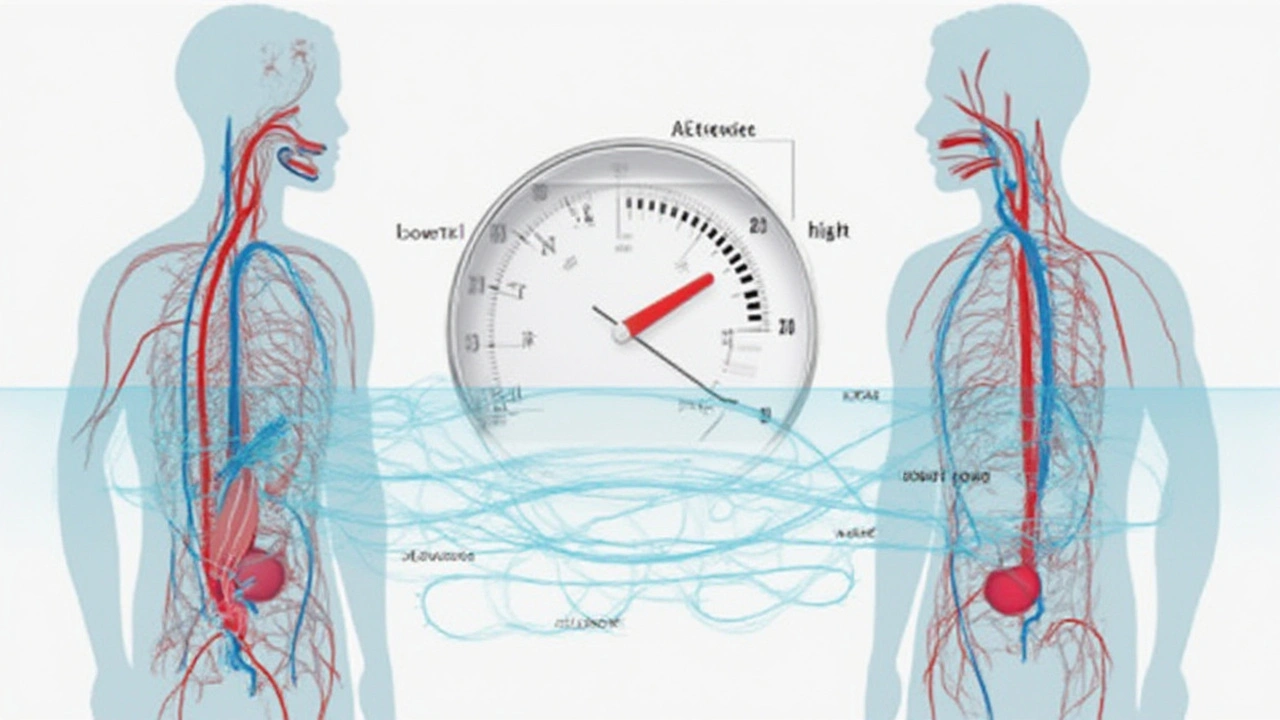Here's something that might surprise you: nearly half of adults in the United States will face high blood pressure at some point in their lives. It sneaks up, barely noticed, but carries serious risks if left unchecked. That's where Atacand comes in. It's a medication that's quietly done some heavy lifting in the world of hypertension, but most people outside the pharmacy line know little about it except for a name on a bottle.
Parents like me often juggle a swirl of facts: school runs, grocery lists, maybe worrying about that extra bag of salty chips. But if your doctor tells you it's time to manage your blood pressure with Atacand, there’s a whole batch of questions that pop up—What exactly does it do? Is it safe? Why this and not something else? Let's untangle it all and give you more than just the basics.
What Is Atacand and How Does It Work?
First up: Atacand, known generically as candesartan cilexetil, belongs to a class of meds called angiotensin II receptor blockers, or ARBs for short. That name sounds complicated, but the logic behind it? Not so much. Your body naturally creates a hormone called angiotensin II, which tells your blood vessels to tighten up, raising your blood pressure. What Atacand does is block that signal—almost like telling your blood vessels to chill out, relax, and stop squeezing so hard.
The impact is huge. When the vessels stay a bit wider and looser, your heart doesn’t need to pump as forcefully. Blood flows more easily, and voila, the pressure drops. Doctors often recommend Atacand for adults with hypertension (high blood pressure) or for people with heart failure who need extra support. It's not just your run-of-the-mill pill, either—studies have shown that ARBs like candesartan may help reduce the risk of strokes and kidney problems, especially in people dealing with diabetes.
If you love cold, hard numbers, here’s a quick stat for you: a well-run clinical trial showed that people on Atacand lowered their systolic blood pressure (the upper number) by an average of 10-15 mmHg compared to placebo groups. That's a real-world difference, especially over months and years.
| Effect | Average Change with Atacand |
|---|---|
| Systolic BP Drop | 10-15 mmHg |
| Diastolic BP Drop | 5-8 mmHg |
| Reduction in Heart Failure Hospitalization | About 30%* |
| Improved Kidney Function (in diabetics) | Significant |
*Based on the CHARM-Alternative trial, a well-known study among heart failure specialists.
One more useful fact: Atacand is available in tablet form, usually in strengths ranging from 4 mg to 32 mg. The typical starting dose for adults is 8 mg or 16 mg once daily, adjusted depending on your needs and response. Always, always, always take it close to the same time each day—that helps your body settle into a routine.
Who Should and Shouldn’t Take Atacand?
Doctors usually weigh the pros and cons before pulling out a prescription. Atacand is great for people dealing with high blood pressure, chronic heart failure, or sometimes even for protecting the kidneys in folks with Type 2 diabetes and protein in their urine.
But—big but—there are some clear lines in the sand. Pregnant women should steer clear, especially beyond the first trimester. Atacand can harm an unborn baby, which the FDA lists as a clear risk. So if you’re planning to have kids or you think you might be pregnant, your doctor will want a different solution.
Some people with certain kidney or liver issues may also need a different or lower dose. Those battling severe dehydration (maybe after a bad stomach bug or being stuck outside in summer heat) should check in with a healthcare provider. The same goes for people taking potassium supplements or potassium-sparing diuretics—raising your potassium level too high isn’t good. Hyperkalemia (fancy word for high potassium) can trigger muscle weakness or even heart rhythm problems, which nobody needs.
Let’s not forget allergies. If you’ve ever had an allergic reaction to an ARB before, or a rare condition called hereditary angioedema, Atacand isn’t going to be your friend.
Here’s a tip: make a full list of every pill, vitamin, or supplement you use, even if it’s just Vitamin C. Keeping your doctor clued-in helps avoid surprise drug interactions.

What Are the Side Effects and How to Manage Them?
You might be wondering, will this pill make you feel weird? For a lot of people, Atacand goes down pretty smoothly. Most side effects are mild, but it pays to stay alert. The most common complaints include dizziness, headache, back pain, or cold-like symptoms. Sometimes you’ll hear people mention nasal congestion or a dry cough, but that’s less frequent with ARBs compared to their cousins, the ACE inhibitors.
Lowering your blood pressure too much isn’t unheard of, mostly when you first start or if your dose gets bumped up quickly. So don’t stand up too fast after sitting for a while—nobody likes an unexpected dizzy spell. If you’ve got a kid like my Merrick zipping around the living room, you don’t want to faceplant into a pile of LEGOs.
More rarely, side effects can get serious. Swelling of the face, lips, or tongue means it's time to get help, fast. Odd muscle cramps or irregular heartbeats could point to high potassium; that’s something you want to flag for your doctor right away.
Want a practical tip? Ask your doctor for a blood pressure monitor you can use at home. Keep a little notebook or a note on your phone. If something feels off or you’re not getting the results you expect, share your notes with your doctor. Staying one step ahead keeps you safer.
Don’t stop Atacand suddenly unless your doctor says it’s okay. Suddenly dropping it could spike your blood pressure and undo a lot of progress you’ve made.
Tips for Living Well with Atacand
Taking Atacand isn’t just about popping a pill every morning. Your routine, your food choices, and your habits make a difference. Salt is a sneaky blood pressure enemy—start checking nutrition labels more closely, even on foods that look "healthy." Canned soups, deli meats, and even some breakfast cereals can stack up your sodium quickly.
Keep moving. Even a brisk walk around the block or playing tag with your kids can help your numbers come down. Combining medication with physical activity has been proven to make blood pressure goals more reachable. The American Heart Association says that combining lifestyle changes with medication like Atacand helps more people hit target numbers than either strategy alone.
Alcohol can interfere with blood pressure control and add strain to your liver. Think of it more as a "treat" rather than a daily habit. The same goes for smoking—quitting is hard, but the benefits can't be overstated for anyone dealing with high blood pressure.
Keep all follow-up appointments. Blood tests help spot kidney issues or high potassium levels before you notice anything yourself. If you struggle with remembering to take your medication, set a daily reminder. Link it to something routine—like your morning coffee or brushing your teeth—to make it second nature.
Finally—don’t go it alone. Involve your family, whether that’s sitting down for a lower-sodium meal together, or letting people know what medications you’re on, just in case of an emergency. Even explaining to kids like Merrick that dad needs a little help dealing with "heart numbers" can open the door to support and understanding.

Kelsey Worth
July 15, 2025 AT 05:16so i took this for 3 months and honestly? my bp dropped like my motivation on a monday morning. also i accidentally took it with grapefruit juice once and thought i was gonna die. turns out that’s not a thing with arbs? good to know. also my cat started staring at me like i’m the weird one now.
shelly roche
July 15, 2025 AT 09:14As someone who’s been on this for 5 years and still runs 5Ks twice a week, I just want to say: this pill doesn’t make you weak, it makes you free. Free from dizziness when you stand up. Free from panic when your doctor says ‘your numbers are up.’ Free to actually enjoy your life instead of waiting for the next crisis. And yes, salt is the enemy-but so is guilt. You’re doing better than you think.
Nirmal Jaysval
July 15, 2025 AT 19:03indians take this? lol. we got hypertension because we eat too much pakoda and chai with sugar bricks. this med is just a bandaid. go back to ayurveda bro. turmeric + yoga + no phone after 8pm = cure. also your doctor is probably getting kickbacks from big pharma. just saying.
Emily Rose
July 15, 2025 AT 21:51Just wanted to say thank you for writing this. I’m a single mom and I was terrified to start this med because I thought I’d be ‘weak’ or ‘dependent.’ But reading your note about linking it to coffee and involving your kid? That’s the kind of real talk we need. I started taking mine after brushing my teeth and now my 7-year-old reminds me. We even made a chart. Progress, not perfection.
Benedict Dy
July 17, 2025 AT 15:31The data presented here is statistically significant but methodologically flawed. The CHARM-Alternative trial had a 12% dropout rate, and the placebo group was not adequately matched for baseline renal function. Furthermore, the 30% reduction in hospitalization is relative risk, not absolute-actual numbers show a 2.3% reduction over 3 years. This is not a miracle drug. It’s a moderate intervention with a known side effect profile that is underreported in lay media. Read the original papers before trusting a blog post.
Emily Nesbit
July 18, 2025 AT 04:42Anyone else notice the author used the word ‘voila’ in a medical article? Unprofessional. Also, ‘chill out’ and ‘LEGOS’? This reads like a parenting blog disguised as clinical guidance. If you’re going to write about pharmacology, at least use precise terminology. ‘Angiotensin II receptor blocker’ is not too hard. Stop trying to be cute.
John Power
July 19, 2025 AT 14:00Emily, I get where you’re coming from-but the point isn’t to sound like a textbook. It’s to help people who are scared, overwhelmed, or just plain confused. I’ve seen patients shut down when they hear ‘ARB’ or ‘hyperkalemia.’ But when you say ‘it helps your blood vessels relax’ and tie it to their kid’s LEGO tower? That sticks. This post saved my cousin’s life. She stopped ignoring her BP until she read this. Sometimes ‘cute’ is just care in disguise.
Richard Elias
July 20, 2025 AT 20:34My doc switched me from lisinopril to this because I had that dry cough. I thought I was gonna die from it. Now I just feel like a normal person again. Also, I didn’t know ARBs didn’t mess with potassium like ACE inhibitors do. That’s actually kinda huge. Thanks for the heads-up on the blood tests. I’m gonna start tracking mine now.